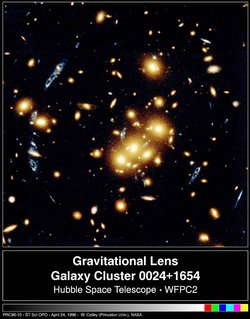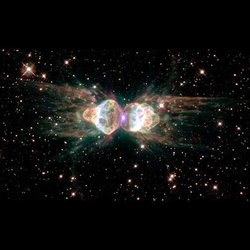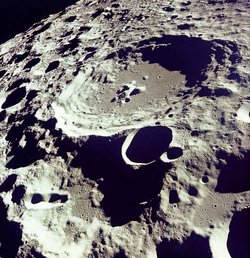Astronomy
|
|
Astronomy is the science involving the observation and explanation of events occurring beyond the Earth and its atmosphere. It studies the origins, evolution, and physical and chemical properties of objects that may be observed in the sky (and are beyond the atmosphere), as well as the connected processes and phenomena.
Astronomy is one of the few sciences where amateurs can still play an active role, especially in the discovery and monitoring of transient phenomena. Astronomy is not to be confused with astrology, which assumes that people's destiny and human affairs in general are correlated to the apparent positions of astronomical objects in the sky -- although the two fields share a common origin, they are quite different; astronomers embrace the scientific method, while astrologers do not.
| Contents |
Divisions of astronomy
In ancient Greece and other early civilizations, astronomy consisted largely of astrometry, measuring positions of stars and planets in the sky. Later, the work of Kepler and Newton paved the way for celestial mechanics, mathematically predicting the motions of celestial bodies interacting under gravity, and solar system objects in particular. Much of the effort in these two areas, once done largely by hand, is highly automated nowadays, to the extent that they are rarely considered as independent disciplines anymore. Motions and positions of objects are now more easily determined, and modern astronomy concerns itself much more with trying to observe and understand the actual physical nature of celestial objects—what makes them "tick".Ever since the twentieth century the field of professional astronomy has tended to split into observational astronomy and theoretical astrophysics. Although most astronomers incorporate elements of both into their research, because of the different skills involved, most professional astronomers tend to specialize in one or the other. Observational astronomy is concerned mostly with acquiring data, which involves building and maintaining instruments and processing the resulting information; this branch is at times referred to as "astrometry" or simply as "astronomy". Theoretical astrophysics is concerned mainly with figuring out the observational implications of different models, and involves working with computer or analytic models.
The fields of study can also be categorized in other ways. Categorization by the region of space under study (e.g., Galactic astronomy, Planetary Sciences); by subject, such as star formation or cosmology; or by the method used for obtaining information.
By subject or problem addressed

- Astrometry: the study of the position of objects in the sky and their changes of position. Defines the system of coordinates used and the kinematics of objects in our galaxy.
- Astrophysics: the study of physics of the universe, including the physical properties (luminosity, density, temperature, chemical composition) of astronomical objects.
- Cosmology: the study of the origin of the universe and its evolution. The study of cosmology is theoretical astrophysics at its largest scale.
- Galaxy formation and evolution: the study of the formation of the galaxies, and their evolution.
- Galactic astronomy: the study of the structure and components of our galaxy and of other galaxies.
- Extragalactic astronomy: the study of objects (mainly galaxies) outside our galaxy.
- Stellar astronomy: the study of the stars.
- Stellar evolution: the study of the evolution of stars from their formation to their end as a stellar remnant.
- Star formation: the study of the condition and processes that led to the formation of stars in the interior of gas clouds, and the process of formation itself.
- Planetary Sciences: the study of the planets of the Solar System.
- Astrobiology: the study of the advent and evolution of biological systems in the Universe.
Also, there are other disciplines that may be considered part of astronomy:
See list of astronomical topics for a more exhaustive list of astronomy-related pages.
Ways of obtaining information
- Main article: Observational astronomy.
In astronomy, information is mainly received from the detection and analysis of electromagnetic radiation and photons, but information is also carried by cosmic rays, neutrinos, meteors, and, in the near future, gravitational waves (see LIGO and LISA).
A traditional division of astronomy is given by the region of the electromagnetic spectrum observed:
- Optical astronomy is the part of astronomy that uses specialized equipment to detect and analyze light in and slightly around the wavelengths that can be detected with the eyes (about 400 - 800 nm). The most common tool is the telescope, with electronic imagers and spectrographs.
- Infrared astronomy deals with the detection and analysis of infrared radiation (wavelengths longer than red light). The most common tool is the telescope but with the instrument optimized for infrared. Space telescopes are also used to eliminate noise (electromagnetic interference) from the atmosphere.
- Radio astronomy detects radiation of millimetre to dekametre wavelength. The receivers are similar to those used in radio broadcast transmission but much more sensitive. See also Radio telescopes.
- High-energy astronomy includes X-ray astronomy, gamma-ray astronomy, and extreme UV (ultraviolet) astronomy, as well as studies of neutrinos and cosmic rays.

Optical and radio astronomy can be performed with ground-based observatories, because the atmosphere is transparent at the wavelengths being detected. Infrared light is heavily absorbed by water vapor, so infrared observatories have to be located in high, dry places or in space.
The atmosphere is opaque at the wavelengths used by X-ray astronomy, gamma-ray astronomy, UV astronomy and (except for a few wavelength "windows") Far infrared astronomy, so observations must be carried out mostly from balloons or space observatories. Powerful gamma rays can, however be detected by the large air showers they produce, and the study of cosmic rays can also be regarded as a branch of astronomy.
History of astronomy
- Main article: History of astronomy.
In early times, astronomy involved only the observation and predictions of the motions of the naked-eye objects. The Rigveda refers to the 27 constellations associated with the motions of the sun and also the 12 zodiacal divisions of the sky. The ancient Greeks made important contributions to astronomy, among them the definition of the magnitude system. The Bible contains a number of statements on the position of the earth in the universe and the nature of the stars and planets, most of which are poetic rather than literal; see Biblical cosmology. In 500 AD, Aryabhata presented a mathematical system that described the earth as spinning on its axis and considered the motions of the planets with respect to the sun.
Observational astronomy was mostly stagnant in medieval Europe, but flourished in the Iranian world and other parts of Islamic realm. The late 9th century Persian astronomer al-Farghani wrote extensively on the motion of celestial bodies. His work was translated into Latin in the 12th century. In the late 10th century, a huge observatory was built near Tehran, Persia (now Iran), by the Persian astronomer al-Khujandi, who observed a series of meridian transits of the Sun, which allowed him to calculate the obliquity of the ecliptic. Also in Persia, Omar Khayyam performed a reformation of the calendar that was more accurate than the Julian and came close to the Gregorian. Abraham Zacuto was responsible in the 15th century for the adaptations of astronomical theory for the practical needs of Portuguese caravel expeditions.
During the Renaissance, Copernicus proposed a heliocentric model of the Solar System. His work was defended, expanded upon, and corrected by Galileo Galilei and Johannes Kepler. Galileo added the innovation of using telescopes to enhance his observations. Kepler was the first to devise a system that described correctly the details of the motion of the planets with the Sun at the center. However, Kepler did not succeed in formulating a theory behind the laws he wrote down. It was left to Newton's invention of celestial dynamics and his law of gravitation to finally explain the motions of the planets. Newton also developed the reflecting telescope.
Stars were found to be faraway objects. With the advent of spectroscopy it was proved that they were similar to our own sun, but with a wide range of temperatures, masses, and sizes. The existence of our galaxy, the Milky Way, as a separate group of stars was only proven in the 20th century, along with the existence of "external" galaxies, and soon after, the expansion of the universe, seen in the recession of most galaxies from us. Modern astronomy has also discovered many exotic objects such as quasars, pulsars, blazars and radio galaxies, and has used these observations to develop physical theories which describe some of these objects in terms of equally exotic objects such as black holes and neutron stars. Cosmology made huge advances during the 20th century, with the model of the Big Bang heavily supported by the evidence provided by astronomy and physics, such as the cosmic microwave background radiation, Hubble's Law, and cosmological abundances of elements.

Timelines in astronomy
- artificial satellites and space probes
- astronomical maps, catalogs, and surveys
- black hole physics
- cosmic microwave background astronomy
- cosmology
- galaxies, clusters of galaxies, and large scale structure
- natural satellites
- other background radiation fields
- solar astronomy
- solar system astronomy
- stellar astronomy
- telescopes, observatories, and observing technology
- the Big Bang
- the interstellar medium and intergalactic medium
- the Universe
- white dwarfs, neutron stars, and supernovae
See also
- List of astronomical topics
- Astronomers and Astrophysicists
- Space science
- Astronomical naming conventions
- Astronomical symbols
- Astronomical object
- Astronomical cycles
- International Astronomical Union
- American Astronomical Society
- Royal Astronomical Society
- European Southern Observatory
Astronomy tools
| General subfields within the Natural sciences |
|---|
| Astronomy | Biology | Chemistry | Earth Sciences | Ecology | Physics |


